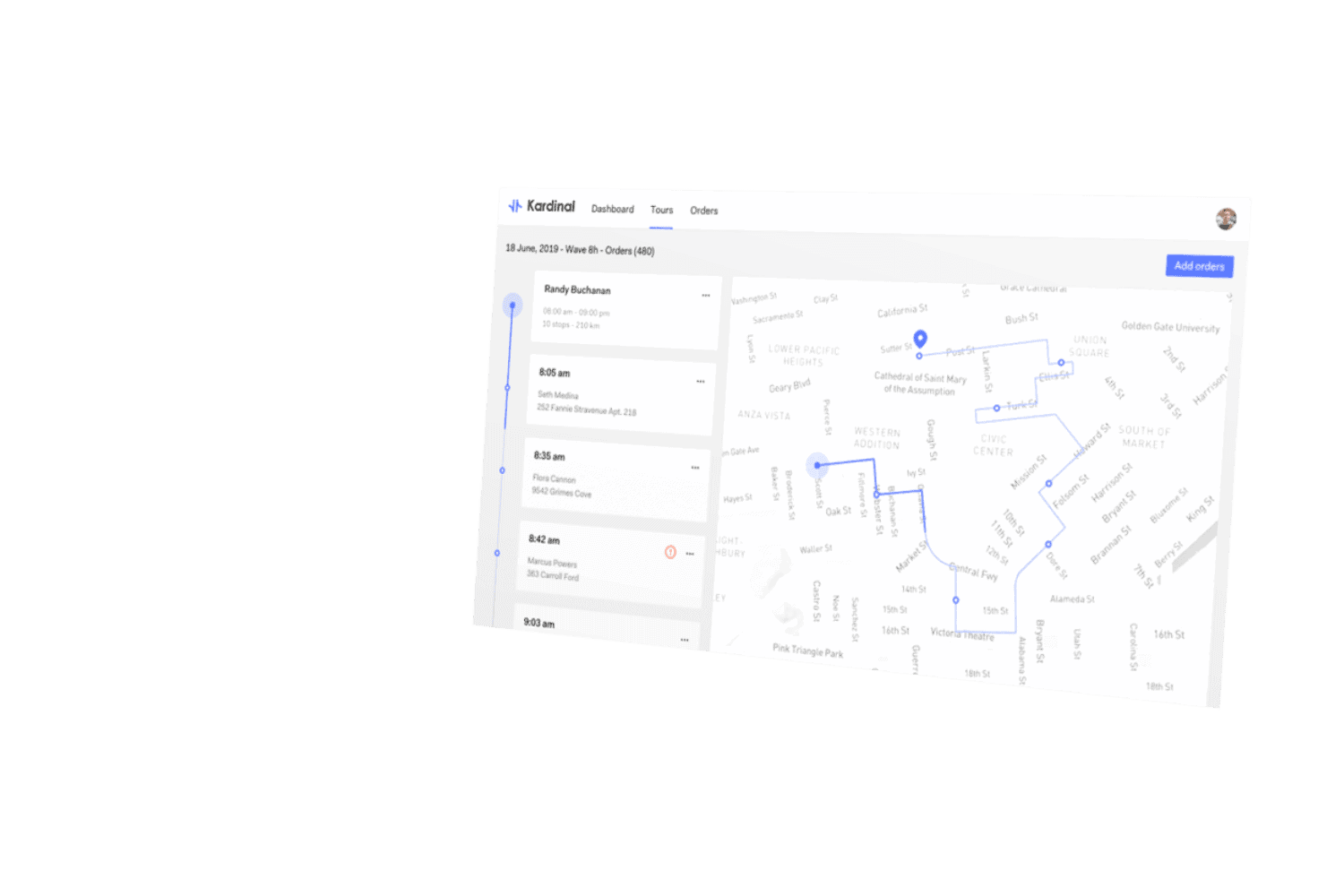How can you optimize your routes to make them relevant?
- May 10, 2021
- 3 mins
Optimization is a powerful tool for improving performance for all businesses requiring route planning.
However, in reality we notice that few carriers and last mile delivery professionals use an optimization software. They often fear, rightfully, that they will pay too much for a solution which, once in place, will not deliver the expected benefits.
In our previous post “What’s wrong with route optimization?“, we identified the 4 major obstacles to the implementation of a route optimization solution:
- Low-quality data
- Data is not in the database
- Specific business constraints
- Dynamic business context
At Kardinal, we believe that these issues must be solved (at least in part) within the product we provide to our customers. How do you design a truly relevant route optimization solution? What kind of user experience should be created to make the solution usable in spite of everyday uncertainties? These are the questions we try to answer in this article, and of course in the daily work of our product team.
Adjust data on the go
Usually, route optimization tools work in the following way:
- Data import / recovery
- Route calculation by algorithms
- Stop calculations
- Route generation
- Manual adjustments if necessary
- Sending the routes to the drivers
With this method, if a piece of data is wrong (incorrect geocoding for example) or was not known before launching the optimization (a late driver for example), it is easy to notice it when the routes are calculated as inconsistencies will be visible. But it is a bit late. If you want to correct the data, you have to start again from step 1 and import the data.
All these steps are a real headache for planners, who often finish planning manually.
At Kardinal, we have made the bold choice to design a continuous optimization system that never stops optimizing. Thus, a data error can be corrected in our interface or in the customer’s TMS without redoing the route optimization from scratch.
Real-time hazard management
Kardinal’s optimization software works continuously: it supports operational staff even after the drivers have left the warehouse, and continues to optimize the routes in real time according to the hazards that arise on the road. This allows our customers to consider use cases that would be impossible with a static approach:
- Identify potential assignment transfers (pick-ups, technical interventions, etc.) between drivers depending on the progress of each round (during the day)
- Identify time slots that will not be met (due to an absent customer who had to be visited twice for example) and made adjustments on the round to maintain the highest quality of service by delivering all customers on time
- Change the order of deliveries according to the real time traffic situation and traffic jams
- And so on.
At Kardinal, the concept of continuous optimization is paramount. We believe that it is the best solution to help carriers face the new challenges of urban logistics.
Continuous route optimization solution
Improving data over time
Supporting drivers on the road also means being able to collect “field data”. This data can then be used :
- to compare theoretical and completed routes to understand where the differences come from
- to improve the relevance of future route optimizations: the Kardinal solution integrates Machine Learning algorithms capable of identifying the theoretical/completed discrepancies and defining the explanatory variables from the collected data.
For example: a carrier delivers furniture in B2C and the agorithm has defined a delivery time of 10 minutes on average for each address delivered. In practice, this indicator shows significant variations since the time spent at each address by a delivery person varies between 5 and 20 minutes. Over time and by “probing” the collected data, Machine Learning algorithms are able to identify that certain variables, namely the size of the package, the weight of the package, if there’s an elevator or not, building code, if there’s one or two delivery drivers, the floor to be delivered, the location of the address, etc.
The algorithms learn from the data and improve their future predictions by adapting the delivery time according to these characteristics (instead of considering 10 minutes whatever the context).
Unlimited constraint modeling capabilities
Most standard tools provide basic logistics constraints such as driver schedules, delivery slots or vehicle capacities. They build an algorithm capable of solving all the cases that fit into this framework.
However, in practice, for the major operators, their activity never quite fits into the framework… Indeed, these constraints and objectives are generally too general to describe precisely what the user needs. Some examples:
- No more than X vehicles can be delivered simultaneously at a given location
- Some customers are more important than others
- Some providers are more important than others
- There is no specific delivery time, but from the time the goods are picked up, we have 1 hour to deliver them
- And so on.
The number of different settings is unlimited, and often the user is forced to adapt to the software’s modeling capabilities, which are limited by the framework. It is difficult to make this framework evolve, because the optimization algorithm is built to solve everything in this precise framework, and changing the framework often amounts to changing the algorithm itself!
At Kardinal, we therefore decided to build an algorithm capable of solving all possible route optimization problems. This is what we call a solver. As long as the problem to be solved involves route optimization, regardless of the constraints, the same high-performance algorithm will be able to carry out the planning. This allows us to include all the new constraints that we encounter with all our new customers in a few days, without compromising on the algorithm’s performance.
Conclusion
While last-mile management is always about moving goods or people to a destination, the practicalities of this transport are extremely diverse. Indeed, we have never encountered two identical logistic situations.
The challenge for us publishers is to provide a standard approach (i.e. to have the same code rolled out to all customers), while at the same time providing a solution that is tailored to their specific situation to remain relevant.
The “Always On” optimization and the use of Machine Learning are some of the powerful and ambitious concepts that we are implementing at Kardinal to finally provide efficient solutions to these challenges.

About the Author
Cédric Hervet has a PhD in Applied Mathematics and is co-founder of Kardinal. For over 10 years, he has been studying and designing Artificial Intelligence systems for industrial applications in telecommunications, digital marketing and transportation. His dual expertise in statistics/machine learning and algorithms/operational research allows him to bring together these two major sets of techniques to design the intelligent systems of tomorrow.







